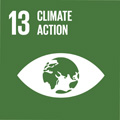- Docente: Francesco Brardinoni
- Credits: 6
- SSD: GEO/04
- Language: Italian
- Teaching Mode: Traditional lectures
- Campus: Bologna
- Corso: Second cycle degree programme (LM) in Geology and Territory (cod. 9073)
Learning outcomes
Students learn about the main satellite platforms and sensors for Earth Observation, are introduced to ArcGIS and apply a number of commands through a set of lab exercises dealing with Earth Surface dynamics
Course contents
1. Geographic Information Systems as tools for integrating georeferenced data collected across spatial and temporal scales;
2. Raster data, Digital Terrain Models and main topographic variables for the quantitative analysis of the Earth's Surface;
3. Vector-based data for building geo-referenced inventories and performing digital mapping;
4. Aerial photographs, staellite imagery and mapping applications;
5. Multi-temporal mapping for documenting environmental change (e.g., land use, landslide activity, active channel width, glacier change and rock glacier inventories for permafrost evaluation);
6. LiDAR technology for the acquisition of high-resolution digital topography: DTM and DSM.
7. Digital drainage basins and drainage networks;
8. Topographic curvature and surface roughness;
9. Practical examples of remote sensing for compiling geomorphic databases;
10. Integrating remotely sensed, field based and geophysical data;
11. Geomorphic Change Detection applied to sequential Digital Terrain Models.
Readings/Bibliography
Readings and lectures posted online.
Teaching methods
Lectures and six GIS lab sessions. Students are distributed in alphabetical order in two groups.
Lab 1 - Introduction to ArcCatalogues, ArcMap and ArcToolbox.
Lab 2 - Introduction to basic operations on raster and vector-based files.
Lab 3 - Multi-temporal mapping of Ventina glacier and climate change assessment.
Lab 4 - Digital delineation of drainage basins and automated extraction of fluvial channel networks.
Lab 5 - Working with geomorphometric parameters: topographic curvature and surface roughness.
Lab 6 - Group project (students work in teams of two) - Historical multi-temporal mapping (e.g., landslides, rivers, glaciers, rock glaciers, coast lines, land use) and quantitative analysis of geomorphic change. Students select an Italian study area and map changes on WMS-based imagery and Google Earth.
Assessment methods
Report 1: a guided report summarizing the main products and outcomes obtained during the labs (40%);
Digital oral presentation in class and discussion of the work conducted by groups in lab 6 (35%);
Report 2: report based on the group project (25%).
Teaching tools
Computer-based video projections and interactive group presentations/discussions.
Office hours
See the website of Francesco Brardinoni
SDGs

This teaching activity contributes to the achievement of the Sustainable Development Goals of the UN 2030 Agenda.
